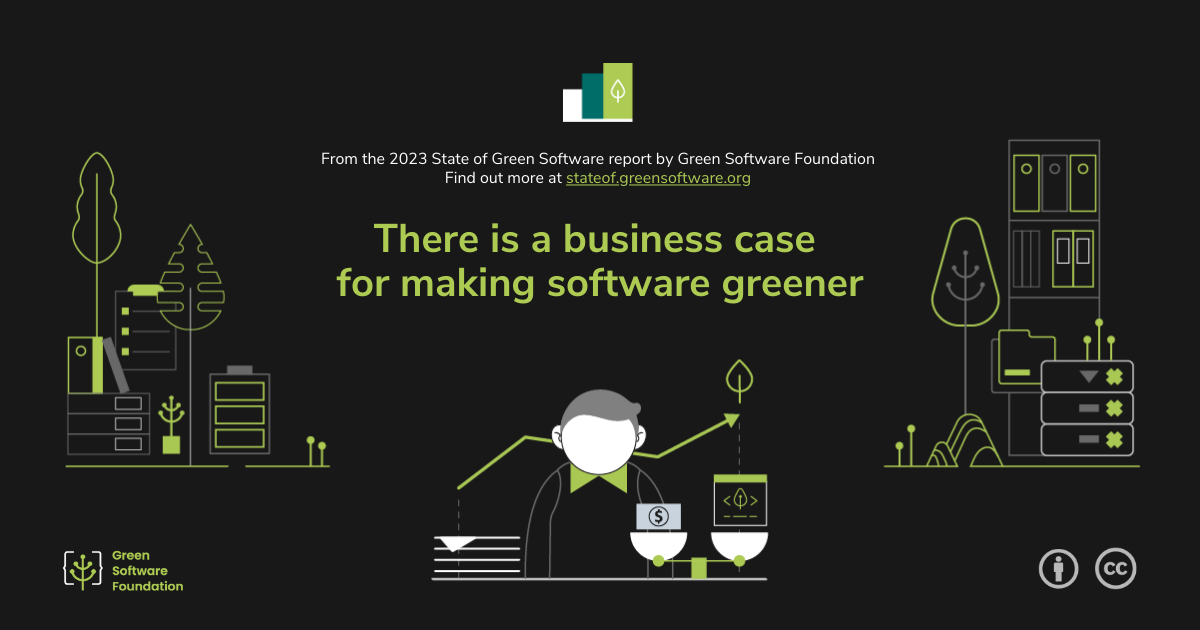There is a business case for making software greener
While green software is a growing field and area of business interest, some organizations are concerned about their return on investment, delaying investment and adoption. Some SOGS survey respondents said that while they rank sustainability as an important component of the software they produce, their employers would rank cost, quality, or profitability over sustainability. A SOGS respondent said, “I’d like to see more about the tradeoffs of applying green software with security, reliability, and above all, cost.” Another practitioner said, “My team is interested but is worried any changes would be difficult to implement with marginal rewards.” One person told us they felt the SOGS survey should also have asked, “How much is your company willing to invest in terms of time and costs to make green software happen?” Another respondent lamented that “It’s just really hard to incorporate green software practice into real-life software companies with a lot of pressure from management and limited budgets.” Clearly, there is a gap between the potential sustainability and business-related benefits that software practitioners think green software can offer and the current interests of many decision-makers in the ICT industry.
The importance of open-source software, and the lack of investment in open-source solutions, were concerns raised by SOGS survey respondents. One shared, “There is a systematic funding gap for creating public goods such as greener algorithms or greener open-source libraries or greener open-source software. Neither research funding nor start-up funding applies to non-profit engineering.” That said, there is evidence that open-source software is a growing area of business interest, and green software is poised to be part of that investment. According to Open Logic’s 2022 State of Open Source report, in a survey of businesses that use open-source software, 77% of respondents said they had increased their use of open-source software in the past year, and 37% of respondents said they had significantly increased their use of open-source software. IEEE Computer Society presents many business-related benefits of green software, including more collaboration and innovation across companies, better scalability and flexibility, and enhanced security since stakeholders can quickly catch and fix security issues.
Along with benefits, green software offers some business incentives. The Green Business Bureau provides an overview of the ROI on sustainability in business, including cost savings from waste reduction and lower energy costs, risk avoidance, and employee retention. Forrester also describes some of the payoffs of sustainability: “Internally, some of the biggest drivers come from an optimized value chain, operational efficiency, employee retention, and workplace satisfaction. Externally, a clear sustainability roadmap leads to more client opportunities, better branding, and adherence to government mandates.” McKinsey sees many business opportunities related to green IT because of net zero pledges and increasing consumer and regulatory pressures on companies. They refer to carbon measurement and reporting, energy efficiency, and power system tech and analytics as areas of opportunity, all of which are connected to green software. With ESG regulation, green software will help companies reach their net zero goals and offer new sites for innovation.
Embracing green technology will be a business imperative, as many corporations face pushback from shareholders and board members demanding climate risk disclosures. ESG is also prompting activism on the part of investors, who are increasingly worried about sustainable investment practices. According to Morningstar, ESG fund assets reached roughly $2.5 trillion by the end of 2022. A study by Accenture found that organizations that integrate their business, technology, and sustainability goals “are seeing returns on their sustainable technology investments in the form of improved financial metrics, ESG goals, customer experience, innovation, software quality, or hiring ability.”
